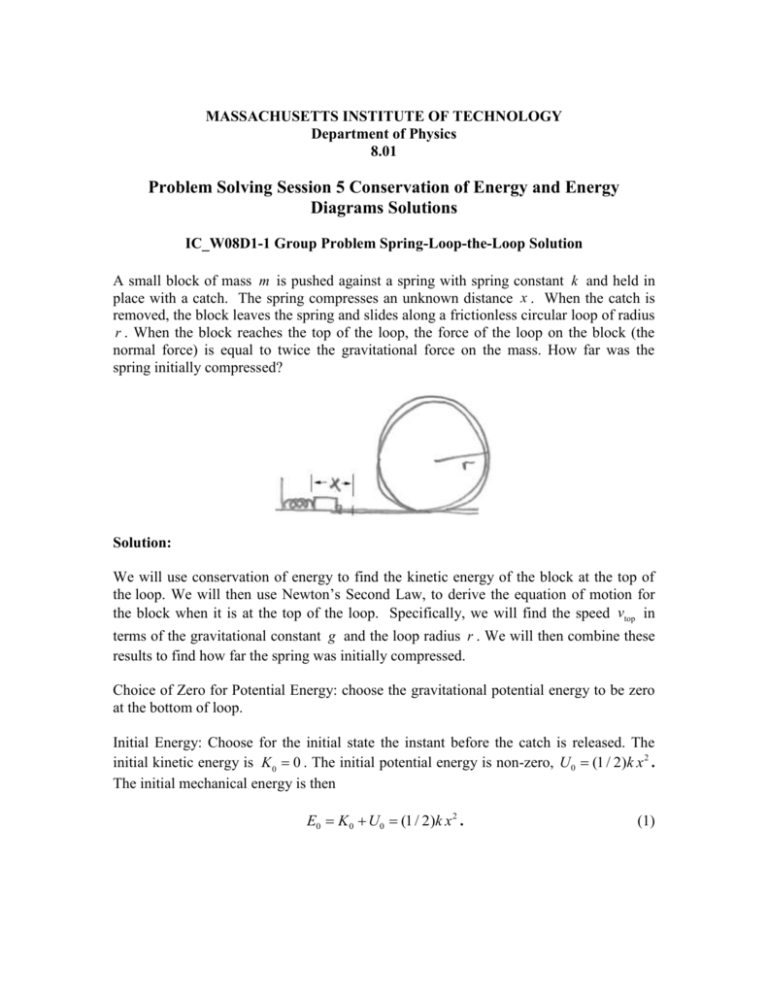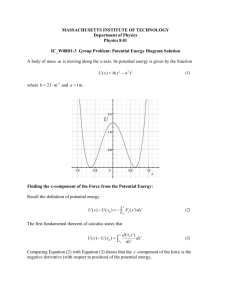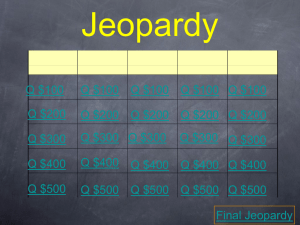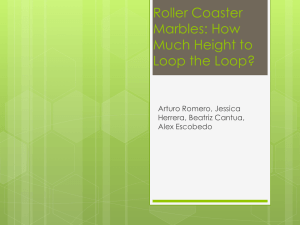MASSACHUSETTS INSTITUTE OF TECHNOLOGY
advertisement

MASSACHUSETTS INSTITUTE OF TECHNOLOGY Department of Physics 8.01 Problem Solving Session 5 Conservation of Energy and Energy Diagrams Solutions IC_W08D1-1 Group Problem Spring-Loop-the-Loop Solution A small block of mass m is pushed against a spring with spring constant k and held in place with a catch. The spring compresses an unknown distance x . When the catch is removed, the block leaves the spring and slides along a frictionless circular loop of radius r . When the block reaches the top of the loop, the force of the loop on the block (the normal force) is equal to twice the gravitational force on the mass. How far was the spring initially compressed? Solution: We will use conservation of energy to find the kinetic energy of the block at the top of the loop. We will then use Newton’s Second Law, to derive the equation of motion for the block when it is at the top of the loop. Specifically, we will find the speed vtop in terms of the gravitational constant g and the loop radius r . We will then combine these results to find how far the spring was initially compressed. Choice of Zero for Potential Energy: choose the gravitational potential energy to be zero at the bottom of loop. Initial Energy: Choose for the initial state the instant before the catch is released. The initial kinetic energy is K 0 0 . The initial potential energy is non-zero, U0 (1 / 2)k x 2 . The initial mechanical energy is then E0 K 0 U0 (1 / 2)k x 2 . (1) Final Energy: Choose for the final state the instant the block is at the top of the loop. The 1 2 final kinetic energy is K f m vtop ; the mass is in motion with speed vtop . The final 2 potential energy is non-zero, U f (mg)(2R) . The final mechanical energy is then E f K f U f 2mgR 1 2 . mvtop 2 (2) Non-conservative Work: Since we are assuming the track is frictionless, there is no nonconservative work. Change in Mechanical Energy: The change in mechanical energy is therefore zero, 0 Wnc Emechanical E f E0 . (3) Mechanical energy is conserved, E f E0 , or 1 1 2 2mgR mvtop k x2 . 2 2 (4) From Equation (4), the kinetic energy at the top of the loop is 1 1 2 mvtop k x 2 2mgR . 2 2 (5) At the top of the loop, the forces on the block are the gravitational force of magnitude mg and the normal force of magnitude N , both directed down. Newton’s Second Law in the radial direction, which is the downward direction, is mg N 2 m vtop R . (6) In this problem, we are given that when the block reaches the top of the loop, the force of the loop on the block (the normal force, downward in this case) is equal to twice the magnitude gravitational force on the block, N 2mg . The Second Law, Equation (6), then becomes 2 m vtop 3 mg . (7) R We can rewrite Equation (7) in terms of the kinetic energy as 3 1 2 mg R m vtop . 2 2 (8) Combing Equations (5) and (8) yields 7 1 mg R k x 2 . 2 2 (9) Thus the initial displacement of the spring from equilibrium was x 7mg R . k (10) IC_W08D1-2 Group Problem: Ball on String Solution A ball of mass m is attached to point a by a string of length L . The ball is held out horizontally as shown in the figure, then released from rest and allowed to fall. When the string becomes vertical it impinges on a fixed peg at point b and the ball begins circular motion about that point. What is the minimum distance D between points a and b necessary to allow the ball to pass above b while still on a circular path? Note that the alternative is for the string to go slack before the ball passes the line between a and b . Solution: From the geometry of the problem the radius of the orbit about the peg is equal to R ( L D) . At the top of its circular path about the peg the ball is a distance L 2 R L 2( L D) 2 D L below its starting point. Choose the starting point to be the zero for the potential energy. Since there is no non-conservative work, mechanical energy is constant throughout the motion and so at the top of the swing about the peg, 1 2 mvT 2 mg (2 D L) 0 . Now use F ma at the top of the circular arc about the peg. Both the tension force of the string acting on the ball (which we denote by T ) the gravitational force on the ball point inward, and the acceleration points inward so the radial force equation becomes mg T mvT 2 /( L D) . We are looking to find the minimum distance D between points a and b necessary to allow the object to pass above b while still on a circular path. This occurs when the T just goes to zero. Therefore mg mvT 2 /( L D ) or rewriting this in terms of the kinetic energy we have that mg ( L D ) 1 mvT 2 . 2 2 We can now combine this with our condition that the mechanical energy is constant yielding mg ( L D) mg (2 D L) 0 . 2 After a little rearranging of terms, the above equation becomes 3 5 mgL mgD 0 . 2 2 We can solve this equation for the minimum distance D : D 3 L. 5 IC_W08D1-3 Group Problem: Potential Energy Diagram A body of mass m is moving along the x-axis. Its potential energy is given by the function U (x) b(x 2 a 2 )2 (11) where b 2 J m-4 and a 1m . Finding the x-component of the Force from the Potential Energy: Recall the definition of potential energy x U (x) U (x0 ) Fx ( x ) dx x0 (12) The first fundamental theorem of calculus states that U (x) U (x0 ) x x0 dU ( x ) dx . dx (13) Comparing Equation (12) with Equation (13) shows that the x -component of the force is the negative derivative (with respect to position) of the potential energy, Fx (x) dU (x) . dx (14) Question 1: What is the x -component of the force associated with the potential energy given by Equation (11)? Answer: To find the x -component of the force from the potential we use Fx (x) dU (x) 4b(x 2 a 2 )x dx Question 2 Make a sketch of the x -component of the force Fx (x) vs. x . Extrema Points: The minimum and maximum points (the extrema) of the potential energy function occurs at the point where the first derivative vanishes dU ( x ) 0. dx (15) Question 3: Find the minimum and maximum points of the potential energy. Answer The extrema points of the potential occur when dU ( x ) 0 dx or equivalently when 0 Fx (x) 2b(x 2 a2 )2x . There are three extrema at x 0 , x a , and x a . Stable Equilibrium Points: Suppose the potential energy function has positive curvature in the neighborhood of a extremum at x0 . If the body is moved a small distance to the point x x0 away from this point x0 , the slope of the potential energy function is positive, dU ( x) dx 0 ; hence the component of the force is negative since Fx dU ( x) dx 0 . Thus the body experiences a restoring force towards the extremum point of the potential. If the body is moved a small distance to the point x x0 then dU ( x) dx 0 ; the component of the force is positive since Fx dU (x) dx 0 . Thus the body again experiences a restoring force towards the extremum point of the potential. Question 4 Which of these extrema points correspond to a stable equilibrium point? Answer: The points x a and x a correspond to stable equilibrium points because if you move slightly away from these points the force is restoring, i.e. the direction of the force is always points towards the equilibrium point. The point x 0 is an unstable equilibrium point. If you move slightly away from x 0 in either direction, the force points away from x 0 . For example consider values of x 0 , from the graph of Fx (x) vs. x , the sign of the x-component of the force is positive hence the force points in the positive x-direction which is away from x 0 . If the object moves in the negative xdirection, then the x-component of the force is negative, which is again pointing away from x 0 . So x 0 is an unstable equilibrium point. You can also use the potential energy graph to determine that x 0 is an unstable equilibrium point. towards the extrema of the potential energy. Such an extremum point is called a stable equilibrium point. Energy Diagram: The mechanical energy at any point x is the sum of the kinetic energy K (x) and the potential energy U (x) E(x) U (x) K(x) (16) Both the kinetic energy and the potential energy are functions of the position of the body. Assume that the mechanical energy is a constant E , then for all points x E(x) E (17) The energy is a constant of the motion and can be either a positive value or zero. When the energy is zero, the body is at rest at the equilibrium positions, x a or x a . A straight horizontal line on the plot of U (x) vs. x corresponds to a non-zero positive value for the energy E . The kinetic energy at a point x1 is the difference between the energy and the potential energy, K (x1 ) E U (x1 ) (18) At the points, where E U (x) , the kinetic energy is zero. Regions where the kinetic energy is negative, are called the classically forbidden regions, which the body can never reach if subject to the laws of classical mechanics. In quantum mechanics, there is a very small probability that the body can be found in the classically forbidden regions. Question 5: Describe what happens to the body if it has energy E 2 J and is located at at x 0 . Answer: At x 0 the body has a positive kinetic energy hence is moving in either the positive or negative x -direction. As the object moves away from x 0 , the kinetic energy increases, whereas if the object moves slightly away from x a or x a , the kinetic energy decreases hence the speed decreases and the object slows down until it eventually stops where K 0 . However the x -component of the force is non-zero at those points (slope of U (x) vs x is non-zero), hence it reverses direction. Question 6: Suppose the body starts with zero speed at x 4a . What is its speed at x 0 and at x a ? Answer: At x 4a , K (4a) 0 . Also U (4a) b(16a 2 a 2 )2 225ba 4 225(2 J m-4 )(1m)4 450 J . Therefore the value of the energy is E E (4a) K (4a) U (4a) 0 450 J=450 J . At x 0 U (0) b(a 2 )2 ba 4 (2 J m-4 )(a 1m)4 2J . So K (0) E U (0) 450 J - 2 J = 448 J . Therefore at x 0 the speed is v(0) 2 K (0) 896 J . m m Similarly at x a , U (a) 0 . So K (a) E U (a) 450 J 0 = 450 J . Therefore at x a , the speed is v(a ) 2 K ( a) 900 J . m m









